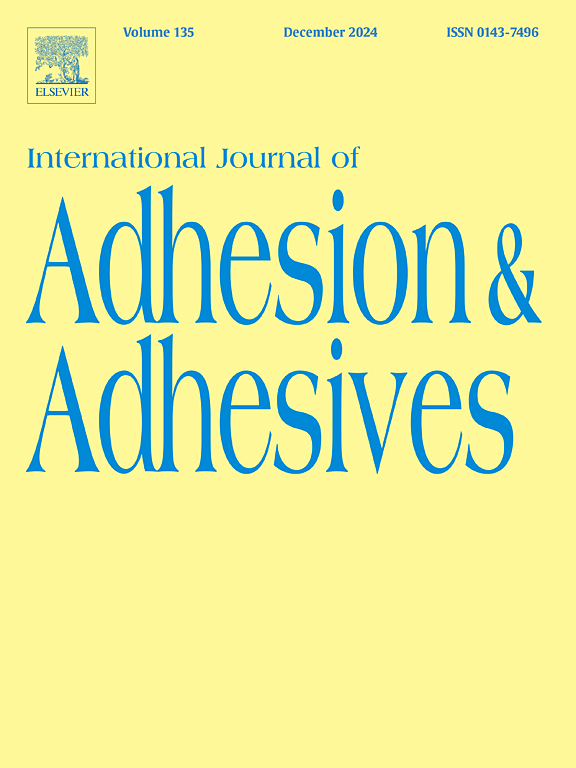Experimental investigation of bio-inspired Bouligand-type CFRP adherends in adhesive joints under multi-rate and multi-directional tensile loading
IF 3.5
3区 材料科学
Q2 ENGINEERING, CHEMICAL
International Journal of Adhesion and Adhesives
Pub Date : 2025-10-01
DOI:10.1016/j.ijadhadh.2025.104170
引用次数: 0
Abstract
This study explores the mechanical performance of adhesively bonded single-lap joints (SLJs) with composite adherends featuring various stacking sequences, including bio-inspired gradual Bouligand helicoidal (G), conventional helicoidal (H), unidirectional (UD), and quasi-isotropic (QI) configurations. Joints were tested under multi-directional (0°, 45°, 90°) and multi-rate tensile loading. A failure load envelope was developed, revealing that UD joints (known for its high stiffness) performed well in 0° loading but showed strong anisotropy at other angles. In contrast, G-type joints demonstrate superior multi-directional integrity, making them promising for applications with variable loading directions. These findings highlight the significance of stacking sequence in optimizing composite SLJ designs for structural applications. Since all joints demonstrated higher performance under tensile loading in the zero-direction, the study was extended to evaluate their behavior under multi-rate tensile testing. Correspondingly, while G- and H-type SLJs exhibited strength comparable to UD joints due to cohesive failure, they showed greater failure displacement and, consequently, higher energy absorption.
多速率多向拉伸加载下仿生bouligand型CFRP粘结接头的实验研究
本研究探讨了具有不同堆叠顺序的复合材料粘附单搭接接头(slj)的力学性能,包括仿生渐进布利甘螺旋(G)、常规螺旋(H)、单向(UD)和准各向同性(QI)构型。在多向(0°、45°、90°)和多速率的拉伸载荷下对接头进行了测试。开发了破坏载荷包络线,表明UD接头(以其高刚度而闻名)在0°载荷下表现良好,但在其他角度表现出很强的各向异性。相比之下,g型接头表现出优越的多向完整性,使其在可变加载方向的应用中具有前景。这些发现突出了堆叠顺序在优化结构应用的复合材料SLJ设计中的重要性。由于所有接头在零方向拉伸载荷下表现出更高的性能,因此将研究扩展到评估其在多速率拉伸试验中的行为。相应的,虽然G型和h型slj接头由于内聚破坏而表现出与UD接头相当的强度,但它们表现出更大的破坏位移,从而具有更高的能量吸收。
本文章由计算机程序翻译,如有差异,请以英文原文为准。
求助全文
约1分钟内获得全文
求助全文
来源期刊

International Journal of Adhesion and Adhesives
工程技术-材料科学:综合
CiteScore
6.90
自引率
8.80%
发文量
200
审稿时长
8.3 months
期刊介绍:
The International Journal of Adhesion and Adhesives draws together the many aspects of the science and technology of adhesive materials, from fundamental research and development work to industrial applications. Subject areas covered include: interfacial interactions, surface chemistry, methods of testing, accumulation of test data on physical and mechanical properties, environmental effects, new adhesive materials, sealants, design of bonded joints, and manufacturing technology.
 求助内容:
求助内容: 应助结果提醒方式:
应助结果提醒方式:


